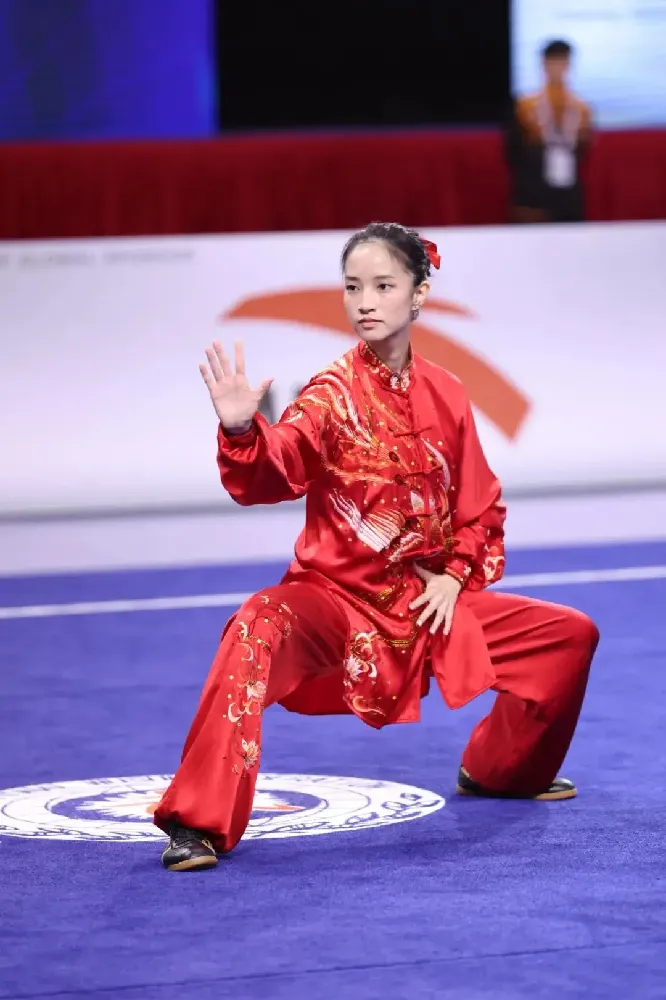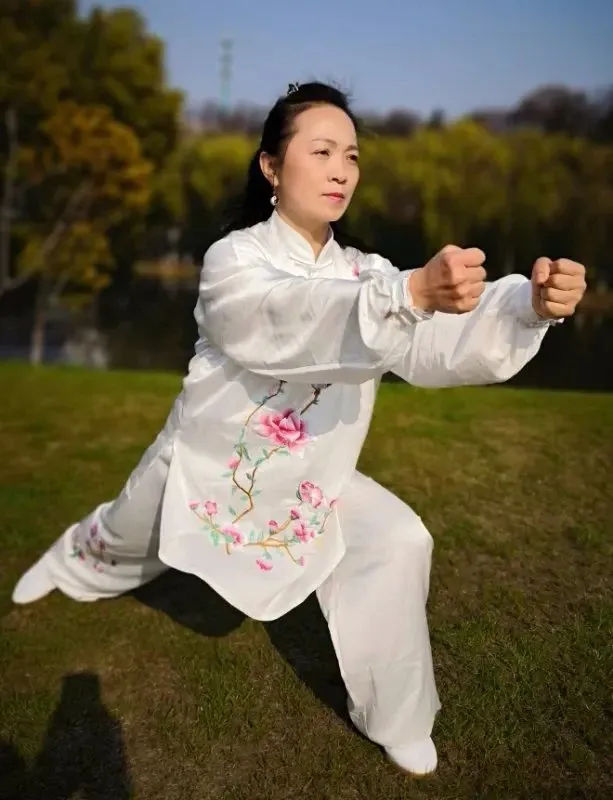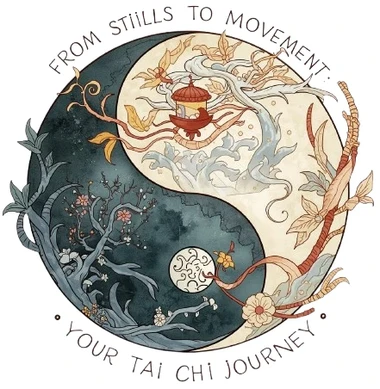The Gateway to a Global Practice
In the world of mind-body disciplines, few practices have achieved the global reach and accessibility of the 24-Step Simplified Tai Chi (24式简化太极拳). Often the first introduction to the art for millions, this routine is far more than a mere sequence of movements.
It is a carefully crafted gateway, a distillation of centuries-old wisdom into a form that is both easy to learn and profoundly deep to master.
At Taichi Wuji, we recognize this form as a monumental achievement in making Tai Chi's benefits available to all.
This guide is designed to be your companion on this journey, offering not just a description of the moves, but a deep understanding of the history, philosophy, and internal principles that give this "simplified" form its incredible power.
We will explore its creation, deconstruct its core elements, and provide a roadmap for your practice, transforming it from a simple exercise into a true moving meditation.

The Historical Genesis of a Modern Classic
To appreciate the 24-Step form is to understand the context of its birth. In 1956, the People's Republic of China, seeking to improve public health and promote a national cultural identity, tasked a committee of experts with creating a standardized Tai Chi routine.
Their goal was ambitious: to preserve the essential health benefits and philosophical core of traditional Tai Chi while making it accessible to the masses, regardless of age or athletic ability.
The committee chose the graceful and expansive Yang-style Tai Chi as their foundation. From this comprehensive system, they extracted 24 essential postures, arranged in a logical, flowing sequence.
The design adhered to a "from easy to difficult" progression, ensuring a gentle learning curve.
This innovation was a resounding success. The 24-Step form became the cornerstone of community exercise programs across China and, eventually, the world.
It demystified Tai Chi, transforming it from an esoteric martial art into a daily practice for public health, all while maintaining a deep connection to its traditional roots.
The Philosophical Underpinnings: More Than Just Movement
The name "Taichi" (太极) itself refers to the "Supreme Ultimate," the conceptual origin of the dualistic forces of Yin and Yang from the state of "Wuji" (无极), or primordial emptiness.
This philosophy is not just abstract theory; it is the very fabric of every movement in the 24-Step form.
- Yin and Yang in Motion: Each posture is a dynamic balance of opposing forces. A solid, weight-bearing leg (Yang) supports a light, empty leg (Yin). An extending arm (Yang) is balanced by a retracting one (Yin). The practice is a continuous, flowing exploration of this dynamic equilibrium.
- The Integration of Mind, Body, and Breath: Tai Chi is a holistic art that combines ancient Daoyin (导引, guiding and pulling) exercises for the body with Tuna (吐纳, exhaling and inhaling) breathing techniques. This synergy is channeled through a framework of traditional Chinese medicine, aiming to unblock and smooth the flow of Qi (vital energy) through the body's meridians. The ultimate goal is to achieve a state of internal and external harmony.
Deconstructing the 24 Movements: A Journey Through the Form
The 24-Step form is typically divided into groups of related movements.
Here, we will explore the essence and internal intention behind key postures, moving beyond the external shape.
Group 1: Establishing the Foundation
This group focuses on grounding, weight transfer, and basic hand-eye coordination.
Commencing Form (起势 - Qǐ Shì)
This is not merely "starting." It is the moment of centering, of connecting to Wuji. As you sink your weight and press your palms gently downward, you are settling your mind, rooting your body to the earth, and gathering your intention (Yi) for the practice ahead.
Parting the Wild Horse's Mane (左右野马分鬃 - Zuǒyòu Yě Mǎ Fēn Zōng)
This is one of the first and most important lessons in weight shifting and spiraling energy. The movement mimics parting tall grass with a gentle, yet firm motion. The power originates from the waist's rotation, driving the force through the arms. It teaches you to move from your core, not your limbs.
White Crane Cools Its Wings (白鹤亮翅 - Bái Hè Liàng Chì)
A beautiful lesson in contrast and stability. One hand rises to protect the head while the other presses down to stabilize the core. The posture embodies a delicate balance between rising and sinking, expansion and contraction, all while standing on one solid leg.
Group 2: Introducing Complexity and Flow
Here, the form introduces more complex coordination and the vital principle of "rooting."
Brush Knee and Twist Step (左右搂膝拗步 - Zuǒyòu Lǒu Xī Ǎobù)
This posture emphasizes coordinated, whole-body movement. As you step, one hand "brushes" past the knee to guard the torso, while the other pushes forward. The key is to synchronize the hand movements with the step and weight shift, creating a unified, powerful motion.
Reverse Reeling Forearm (左右倒卷肱 - Zuǒyòu Dào Juǎn Gōng)
This is a graceful retreat, teaching you how to yield and neutralize force. Instead of a direct block, you draw back, deflecting an incoming force while simultaneously preparing a counter-attack with the other hand. It is a physical manifestation of the Taoist principle of "softness overcoming hardness."
The Core of the Practice: Grasping the Sparrow's Tail
Left and Right Grasping the Sparrow's Tail (左右揽雀尾 - Zuǒyòu Lǎn Què Wěi)
This sequence is the heart of Tai Chi, containing the four primary energies (Peng, Lü, Ji, An). It is a comprehensive lesson in interaction.
- Ward Off (掤 - Péng): An expansive, upward-forward energy that supports and neutralizes.
- Roll Back (捋 - Lǚ): A yielding, redirecting energy that draws an opponent in and off-balance.
- Press (挤 - Jǐ): A focused, concentrated energy that follows the roll back.
- Push (按 - Àn): A sinking, forward energy that releases power from the rooted feet.
- Later Groups: Integrating Balance and Power
The form progressively challenges the practitioner with balances, kicks, and powerful strikes.
Right Heel Kick (右蹬脚 - Yòu Dēng Jiǎo)
This movement requires a high degree of balance and core strength. The stability comes not from the kicking leg, but from the deep root and mental focus of the standing leg.
Snake Creeps Down (左右下势独立 - Zuǒyòu Xià Shì Dúlì) & Golden Rooster Stands on One Leg (左右独立 - Zuǒyòu Dúlì)
This pair is a study in extremes—from the lowest, most grounded posture (low stance) to the highest, most elevated one (single-leg stand). It trains the tendons and ligaments, builds immense leg strength, and cultivates unwavering mental focus.
Turn, deflect, Parry, and Punch (转身搬拦捶 - Zhuǎnshēn Bān Lán Chuí)
This is the most overtly martial part of the form, incorporating a turn, a deflection, a parry, and a powerful punch. It reminds the practitioner that within the soft, flowing exterior lies a potent self-defense system.
The form concludes with the Crossing Hands (十字手 - Shízì Shǒu) and Closing Form (收势 - Shōu Shì), which symbolically gather the energy cultivated during the practice and return it to the lower Dantian, completing the cycle and bringing the practitioner back to a state of calm centeredness.

The Four Pillars of Masterful Practice
Knowing the movements is one thing; practicing them correctly is another.
These four principles are the pillars of an effective Tai Chi practice.
- Mental Quietness and Physical Relaxation (心静体松 - Xīn Jìng Tǐ Sōng): This is the non-negotiable foundation. "Mental Quietness" means clearing the mind of chatter, focusing solely on the movement and breath. "Physical Relaxation" is not being limp; it is a conscious release of unnecessary tension in the joints and muscles, allowing for smooth, unimpeded movement and Qi flow.
- Round, Lively, and Continuous (圆活连贯 - Yuán Huó Lián Guàn): There are no sharp angles or jerky stops in Tai Chi. All movements are circular and connected, like a coiling silk thread. This "continuity" applies both within a single posture ("joints linking") and between postures ("postures linking"), creating a seamless, flowing dance.
- Clear Distinction Between Substantial and Insubstantial (虚实分明 - Xū Shí Fēnmíng): This is the secret to the "light, cat-like" steps. At any moment, your weight must be clearly distributed, with one leg "substantial" (solid, bearing weight) and the other "insubstantial" (light, ready to move). This clear distinction allows for agile, stable, and effortless movement.
- Natural and Coordinated Breathing (呼吸自然 - Hūxī Zìrán): Beginners should not force their breath. Let it be natural. As you advance, the breath will naturally begin to coordinate with the movements—typically exhaling on exertion (e.g., during a push) and inhaling on preparation. The ultimate goal is deep, abdominal breathing that supports and enhances the flow of movement.
Addressing the Controversy and Looking Forward
The 24-Step form is not without its critics. Some purists argue that its simplification stripped away the martial essence and deeper energetic layers, reducing Tai Chi to "Tai Chi Gymnastics."
There is validity in the concern that focusing solely on the external form without instruction on internal energy (Qi) and intent (Yi) limits its potential.
However, this perspective misses the form's revolutionary purpose. It was never meant to replace traditional, long-form training. It was designed as a powerful and effective on-ramp. Its immense value lies in its accessibility.
It has introduced countless individuals to the world of Tai Chi, providing a solid framework upon which dedicated students can build.
For those who wish to go deeper, the 24-Step form provides the essential vocabulary to explore more complex forms and internal practices.
Tai Chi 16 Form: A Step-by-Step Guide with Front & Back Demonstration
Conclusion: Your Journey Begins with a Single Step
The 24-Step Simplified Tai Chi is a masterpiece of pedagogical design. It is a microcosm of the vast Tai Chi universe, containing within its 24 movements the core principles of Yin-Yang theory, holistic health, and mindful movement.
It is a gift to the modern world—a tool for managing stress, improving health, and cultivating a quiet mind in a noisy age.
At Taichi Wuji, we honor this form as both a starting point and a lifelong practice.
We encourage you to learn the sequence, but more importantly, to delve into the principles that animate it.
Be patient with yourself, focus on the process over the product, and allow the practice to reveal its depths to you over time.
Begin your journey today. Explore our in-depth video tutorials and online courses at Taichi Wuji to guide your first steps into this beautiful and transformative art.
Frequently Asked Questions: 24-Step Simplified Tai Chi
What is the difference between 24-Step Tai Chi and traditional Yang Style?
The 24-Step form is a modern compilation derived from the traditional Yang Style. It is shorter, simplified for easier learning, and standardizes the sequence for mass teaching. Traditional Yang Style forms are much longer (e.g., 108 postures), more complex, and contain deeper martial applications and energetic nuances. The 24-Step form is an excellent introduction and foundation for eventually exploring traditional forms.
How long does it take to learn the 24-Step Tai Chi form for a beginner?
With consistent practice (e.g., 3-4 times per week), a motivated beginner can memorize the entire 24-movement sequence in about 1-2 months. However, "learning" goes beyond memorization. Refining the postures, understanding the internal principles (like weight shifting and waist rotation), and developing flow can take years of dedicated practice, making it a lifelong journey of improvement.
What are the main health benefits of practicing 24-Step Tai Chi?
Scientific studies and centuries of practice show that consistent practice of the 24-Step form offers numerous benefits, including: Improved balance and reduced fall risk, enhanced flexibility and joint health, reduced stress and anxiety, lower blood pressure, increased leg strength, and improved mind-body connection and mental focus.
Is 24-Step Tai Chi suitable for seniors or people with limited mobility?
Absolutely. This form was designed for people of all ages and fitness levels. The movements are low-impact, slow, and controlled. It can be adapted to be practiced while seated or using a chair for support. However, it's always recommended to consult with a healthcare provider before starting any new exercise regimen.
Can I learn 24-Step Tai Chi at home by watching videos?
Yes, you can effectively learn the basic sequence and movements through high-quality online tutorials and videos. They are a fantastic resource for getting started and daily practice. However, for correcting subtle postural mistakes and deepening your understanding of the internal principles, occasional guidance from a qualified instructor (online or in-person) is highly beneficial.
What is the most important principle for a beginner to focus on?
While all principles are important, beginners should prioritize <strong>Relaxation (Song) and Weight Shifting (Xu-Shi)</strong>. Avoid using brute force. Consciously relaxing your shoulders, chest, and waist allows for smoother movement. Simultaneously, focus on clearly transferring your weight from one leg to the other, as this is the foundation of Tai Chi's stability and power.
What does "Grasping the Sparrow's Tail" include and why is it so important?
"Grasping the Sparrow's Tail" (Lan Que Wei) is not a single move but a sequence of four primary techniques: Ward Off (Peng), Roll Back (Lu), Press (Ji), and Push (An). It is considered the core of the form because it teaches the fundamental energies of Tai Chi—how to receive, neutralize, and issue force. Mastering this sequence is key to understanding the martial and energetic applications of the art.
How does the 24-Step form relate to Qigong and meditation?
The 24-Step form is a form of "moving Qigong" and "moving meditation." Like Qigong, it involves coordinated breath, movement, and mental intent to cultivate and circulate Qi. The requirement for mental focus and mindfulness during the slow, flowing sequence induces a meditative state, calming the nervous system and reducing stress, similar to seated meditation.
